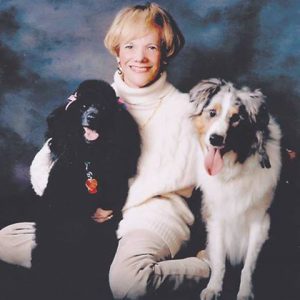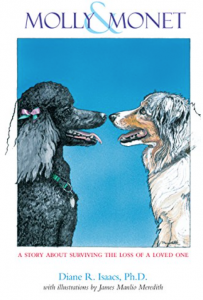 A Grief book written by Dr. Diane R. Isaacs, Ph.D
A Grief book written by Dr. Diane R. Isaacs, Ph.D
Allegorically written through the eyes of two dogs, and sold all over Asia and United States
Grieving is over when it is over. Everyone takes their own time to go from the person they were with (the loved one they have lost in their lives), to the individuals they are going to be when they cross a bridge. That bridge is the grieving process. It is a journey. The journey is painful.
Worden’s Model talks of accepting the reality of one’s loss. The bridge to cross with acceptance is to believe what has really happened, whether it be the death of a spouse, child, family member, life style, divorce, a close friend, a catastrophe, or even an animal. We then move on to experiencing our pain of grief, which teaches us to feel again. After-which we must adjust to the world in which our loss is missing and adapt. It is only then that we may be able to emotionally move on with our lives and find meaning in every day on this earth.
In our society, its not comfortable for many people to be around others who have suffered a major loss in life. People might think, “if it happened to ______, then it can happen to me.” Because of this, the grief stricken suffer fears of expressing emotion and resistance to dealing with deep feelings.
Initially, people tend to close down in the early stages. Consequently, there can be feelings of sadness, depression, isolation, and deep loneliness. Its not just the person one has lost in their lives, but the other losses that take place as a result from the death. Each person with the loss of a loved one is special in their own way. Each story is different. Healthy grieving consists of getting rid of the “shoulder’s” in their lives, and letting one’s self feel the shock.
There are psychological stresses, behavioral changes, emotional changes, and sometimes cognitive changes. These are known as stress.
Our society thinks that many times it is better to just get on with things. Nothing can be farther from the truth to someone who has suffered a major loss in their life. One must work through their grief after the shock begins to wear off. There are no time-tables. It is difficult to accomplish such a task; and its very helpful if its not done alone. Sometimes physical attacks come from our own body, followed the emotions that are in our hearts.
Ultimately, people do recover. They can build a new and different life. The deceased are never forgotten. After working through the pain, with time and understanding, life can and does begin again with new challenges, love, and beauty.
There are a sequence of important stages of time that take place when you have lost a loved one. The first is Notification which include the rituals of funeral and notification of family members and friends.
Next begin the loss of support systems. This is something I must talk about. Life has changed. Some friends and family can be there for the grieving individual while others disappear. Why? Is it too close, or is it painful to watch another suffer, cry, and express their sorrow? All of these things cause pain, sorrow, and loneliness which the individual ultimately begins to adjust to.
There are anniversary dates and the subsequent reactions that go along with them. Holidays, birthdays, and other family celebrations can and will be especially difficult until the survivor begins to re-enter their new life – or cross the bridge from the person they were to the person they are going to be.
My husband was the victim of a violent crime seventeen years before his death. He ultimately died as a result of a gun shot wound he suffered while in front of me. When that gun went off, my life changed forever.
I do not recommend this as a way to grow, but those seventeen years and the last year and a half of his life were filled with love, humor, growth, honesty and open communication. We had much joy with one another as well as much pain as I watched my husband go through 3 liver transplants to prolong his life. He died during the last liver transplant.
Molly came into my life about a year before my husband died. A wondrous and joyful poodle puppy. Molly grew up during the last year and watched as my children and I went through our torment. This is partly Molly’s story, in her words, as she watched, observed, was there for me, and finally witnessed me begin to want and try to adjust to a new life. Molly was unconditional in her love and still is. She too has grieved. I wish to share in this book the many things I’ve learned about living and going on from her.
My current husband Jim’s wife Karen died as a result of complications from severe diabetic disease. She was awaiting a transplant. She was a writer and a wonderful person whom I spent l0 years with. Monet, my Australian Shepherd, came into my life within six months of Karen’s death. He too was unconditionally available for me.
This is Molly and Monet’s story. It is in their words. These are their observations, trials, and tribulations of beginning a new life along with new family members after the painful events took place in Jim and Diane’s life. It is about fighting for power, jealousy, finding friendship with one another, and helping two grieving adults make life bearable and fun. It is through Molly and Monet and grief work, through grief groups, that this story has evolved.



